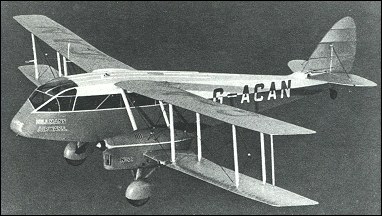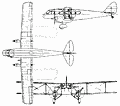 |
De Havilland D.H.84 Dragon1932 |  |
| MEDIUM TRANSPORT | Virtual Aircraft Museum / United Kingdom / De Havilland |
 |
The de Havilland D.H.84 Dragon was designed by Arthur Hagg in response to Fox Moth operator Edward Hillman's request for a twin-engined aircraft to be used on a proposed service from southern England to Paris. The slab-sided plywood box used successfully in the Fox Moth was adopted forthe fuselage of the new design, a two-bay biplane with wings that could be folded outboard of the two de Havilland Gipsy Major engines. The pilot was provided with a separate compartment in the extreme nose and the main cabin could seat six passengers. The prototype made its maiden flight on 12 November 1932, at Stag Lane, Edgware. It was later delivered to Hillman's Airways at Maylands, Essex, together with three examples of the production Dragon 1, which facilitated inauguration of the Paris route in April 1933. British production totalled 115 aircraft built at Stag Lane and, from 1934, at Hatfield. A further 87 were built in Australia during World War II, the de Havilland Australian factory at Bankstown, Sydney, producing navigation trainers for the Royal Australian Air Force, the first of these flying on 29 September 1942. Variants Dragon 2: the 63rd aircraft was the first of an improved version with the glasshouse cabin windows replaced by individual framed transparencies, and with main landing gear fairings D.H.84M: militarised version with a dorsal gun ring and a fin fillet; supplied to Denmark, Iraq and Portugal
|  COMPANY PROFILE | |||||||||||||||||||||||||||||||||||||||||||||||||||||||||
 |

|

